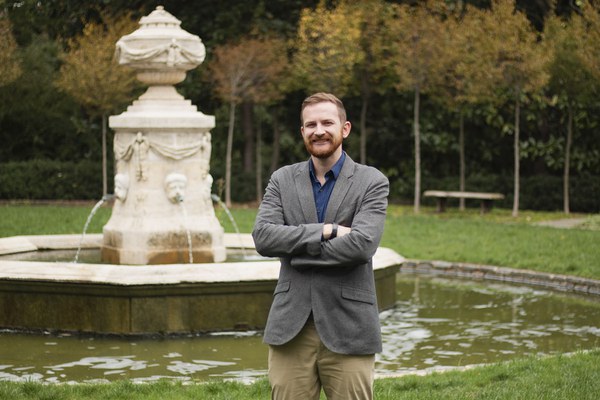James Almeida, a PhD candidate in history at Harvard University, is a Tyler fellow in Pre-Columbian Studies. His recent research presentation, “Coercing the Andes: The Legacies of Inca Forced Labor Practices in Colonial Potosí,” examined racialized forced labor strategies in a silver mint.
Q&A with James Almeida
Why study Andean enslavement and labor history in Potosí?
Europeans first encountered the world’s richest silver deposit in Potosí, now a Bolivian city, in 1545. Potosí is typically considered an indigenous or colonized space, but the first Europeans brought an African presence, too. Gonzalo Pizarro, brother of the famous conquistador Francisco Pizarro, brought enslaved Africans to work his Potosí mine. Pretty consistently until Bolivian independence in the 1820s, about five percent of the population were enslaved people of African descent.
My project looks at the silver mint in Potosí, a protoindustrial space on the main plaza when cities weren’t even that common in the Andes. As many as three hundred people worked there: Europeans who were not necessarily Spaniards, Africans and Afro-descendants, indigenous people, all in the same space. There’s also a state presence. We have really good records because royal officials were on hand, whereas for most of colonial Latin America we get only scattered records when an official came through.
How were Andean traditions—for instance, around chicha—altered in the colonial period?
Chicha is a maize beer. In the Inca period, the best documented in Pre-Columbian times, we know chicha was tightly controlled and restricted to elites, but commoners might drink it on ceremonial occasions. For example, in the annual maize-planting ceremony, the state provided chicha as the lubricant for exchange: people giving their labor to plant crops for the state. Chicha was—and still is—very gendered: produced by women and offered to men for consumption.
Early on at the mint, when a new batch of silver was brought to be coined, the workers were given money to buy chicha, preserving this ceremonial idea of beginning a cycle of work. By the later colonial period, this had really degraded. In the 1750s, the treasurer of the mint was blasted for not giving workers enough food, and chicha was listed, along with jerky, bread, and maize, as one of the mandatory staples to keep people working. It no longer seems to have held any ceremonial importance. The treasurer ordered doubled rations and people stopped fleeing.
Chicha was usually involved in escapes, violence, and social conflicts at the mint. Enslaved people, indigenous Andeans, and even sometimes free people wanting to get away from a difficult job would try to flee. These escapes were sometimes connected with chicha, and sometimes women (both indigenous and Afro-descendant) who sold chicha in the mint were involved. Colonial authorities attempted to prevent this. In the early seventeenth century, the city council tried to shut down chicherías (chicha taverns) because they were said to be hiding fugitive slaves, but thirty-five taverns were still operating within a few blocks of the mint two decades later. So even though chicha lost ceremonial significance, it remained important in colonial society.
What connects this research with your project on Dumbarton Oaks labor history?
My institutional project this year with [Resident Program Director for Garden and Landscape Studies] Thaïsa Way included illuminating life stories of workers on the Dumbarton Oaks property. That’s been pretty difficult because we have poor documentation.
Compared to the Potosí mint, the clues are fewer because Dumbarton Oaks did not have a lot of state presence—it was a private property until it was donated to Harvard in 1940. The region was home to plantations in the eighteenth and nineteenth centuries, but due to its small size, terrain, and semi-urban nature, Dumbarton Oaks wasn’t used as a plantation. But the tools I use are the same: thinking about various forms of labor coexisting in a space, the work people are doing, the conditions, and how that defines their lives.
Similarly to the mint, free laborers worked alongside enslaved people at Dumbarton Oaks, at least in the waning decades of slavery before the Civil War. For many years, owners of the Dumbarton Oaks property also had plantation properties elsewhere with extensive holdings in both land and people. Planter families came to urban places like the Washington area for winter social seasons—opportunities to see friends and extended family as well as to conduct urban business—or, in the case of Vice President John C. Calhoun (resident at Dumbarton Oaks in the 1820s), for the political season in the warmer months. This also involved disrupting enslaved families. Enslaved women tended to be brought to urban properties like Dumbarton Oaks for domestic labor, whereas men might be kept on a plantation to work in the fields. What did it mean to be uprooted from your home for a year or two, or every social season, and then return—or not?
One 1812 document, held at the DC Land Office (because enslaved people were considered real estate) and transcribed in the Dumbarton Oaks archives, stood out to me. A man in his thirties named Griffen Samuel (or Samuel Griffen—it’s not completely clear), enslaved on the property, was manumitted by the mother of the Dumbarton Oaks owner. It’s hard to reconstruct these complicated relationships, but she manumitted him at a difficult time and place for enslaved people to obtain their freedom, and for much less than his purchase price, saying her motivations were “good cause & considerations me thereunto moving as also in consideration of one dollar current money.”
I don’t know for sure what happened to Samuel, but I found two possibilities. The 1830 census lists a Griffin Samuel as a free black man living with a free black woman and girl in Richmond. The plantation he would have been from is halfway between DC and Richmond, so it’s possible he moved to Richmond and started a family. A Samuel Griffin also appears on a DC marriage record from 1851. He would have been in his seventies, but often enslaved people’s marriages were not given official recognition, so he might actually have been married for a long time. Or it could be a son or nephew, or someone with the same name.
It’s an example of the challenges of doing this research but also the stories we can find. We know Samuel was manumitted and left the property a free man.
Julia Ostmann is postgraduate writing and reporting fellow at Dumbarton Oaks. Photo by Elizabeth Muñoz Huber, postgraduate digital media fellow.

